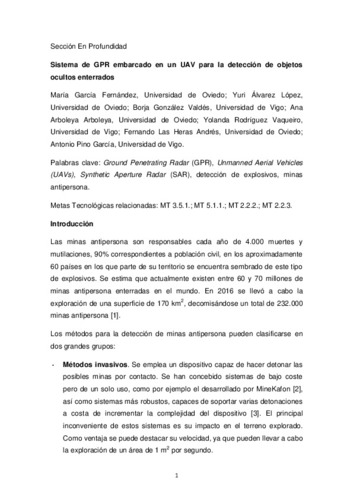Sistema de GPR embarcado en un UAV para la detección de objetos ocultos enterrados
Subject:
drones
georradar
GPR
UAV
imaging
minas antipersona
Publication date:
Editorial:
Subdirección General de Planificación, Tecnología e Innovación
Descripción física:
Abstract:
This work presents a novel system to obtain images from the underground based on Ground Penetrating Radar (GPR). The proposed system is composed by a radar module mounted on board an Unmanned Aerial Vehicle (UAV), which allows the safe inspection of difficult-to-access areas without being in contact with the soil. Therefore, it can be used to detect dangerous buried objects, such as landmines. The radar measurements are coherently combined using a Synthetic Aperture Radar (SAR) algorithm, which requires a cm-level accurate positioning system. In addition, a clutter removal technique is applied to mitigate the reflection at the air-soil interface (due to the impedance mismatching). Besides the aforementioned advantages, the system can detect both metallic and dielectric targets (due to the use of a radar instead of a metal detector) and it allows to obtain high-resolution underground images (due to the SAR processing). The algorithms and the UAV payload are validated with measurements in both controlled and real scenarios, showing the feasibility of the proposed system.
This work presents a novel system to obtain images from the underground based on Ground Penetrating Radar (GPR). The proposed system is composed by a radar module mounted on board an Unmanned Aerial Vehicle (UAV), which allows the safe inspection of difficult-to-access areas without being in contact with the soil. Therefore, it can be used to detect dangerous buried objects, such as landmines. The radar measurements are coherently combined using a Synthetic Aperture Radar (SAR) algorithm, which requires a cm-level accurate positioning system. In addition, a clutter removal technique is applied to mitigate the reflection at the air-soil interface (due to the impedance mismatching). Besides the aforementioned advantages, the system can detect both metallic and dielectric targets (due to the use of a radar instead of a metal detector) and it allows to obtain high-resolution underground images (due to the SAR processing). The algorithms and the UAV payload are validated with measurements in both controlled and real scenarios, showing the feasibility of the proposed system.
ISSN:
Collections
Files in this item




